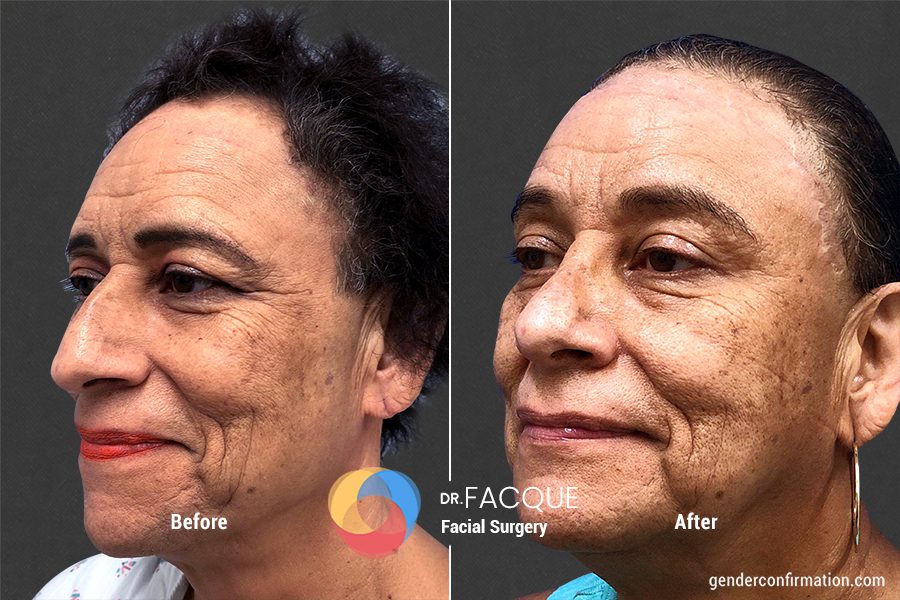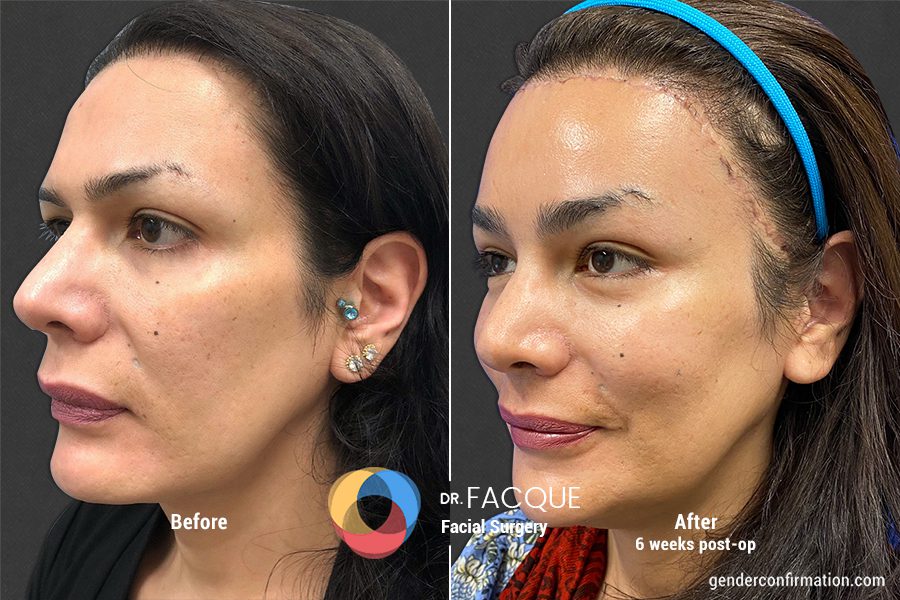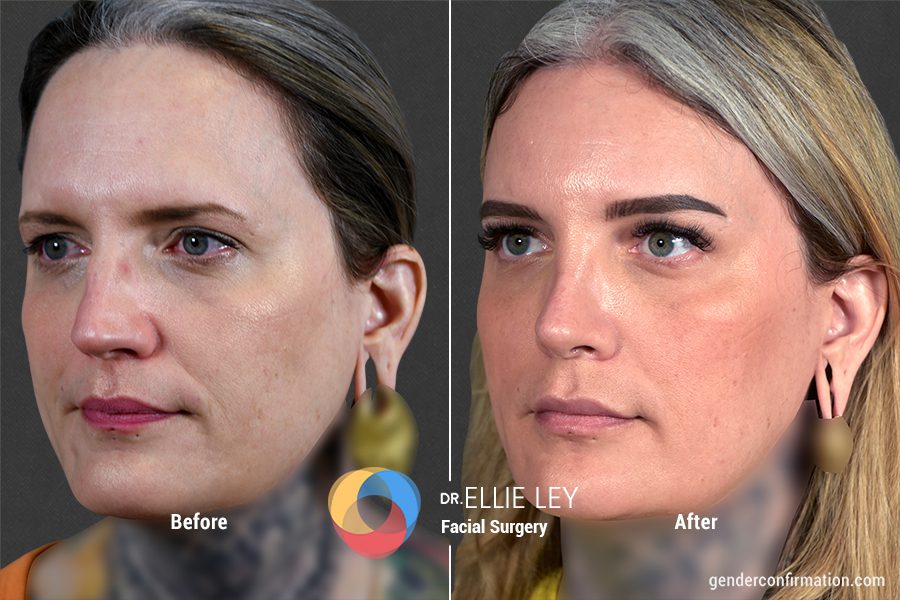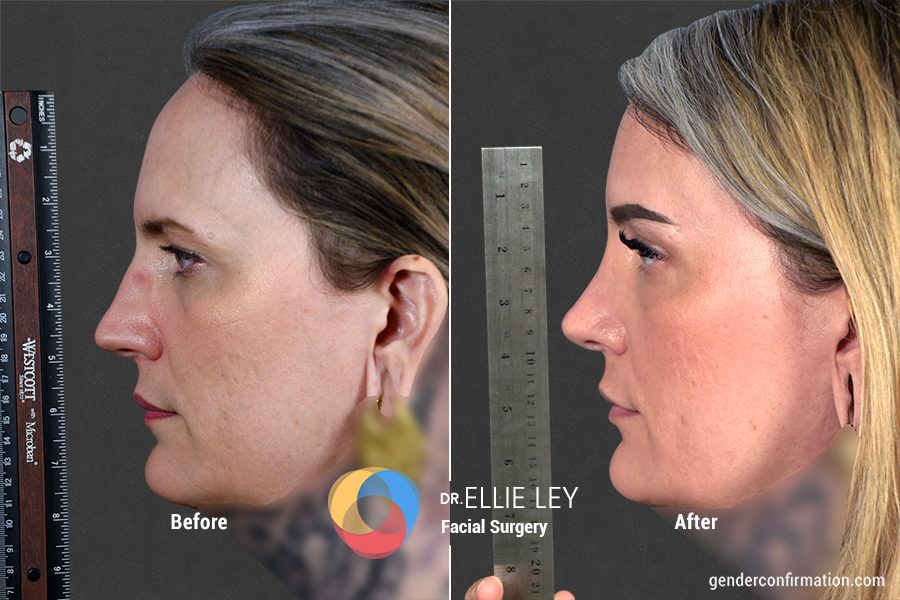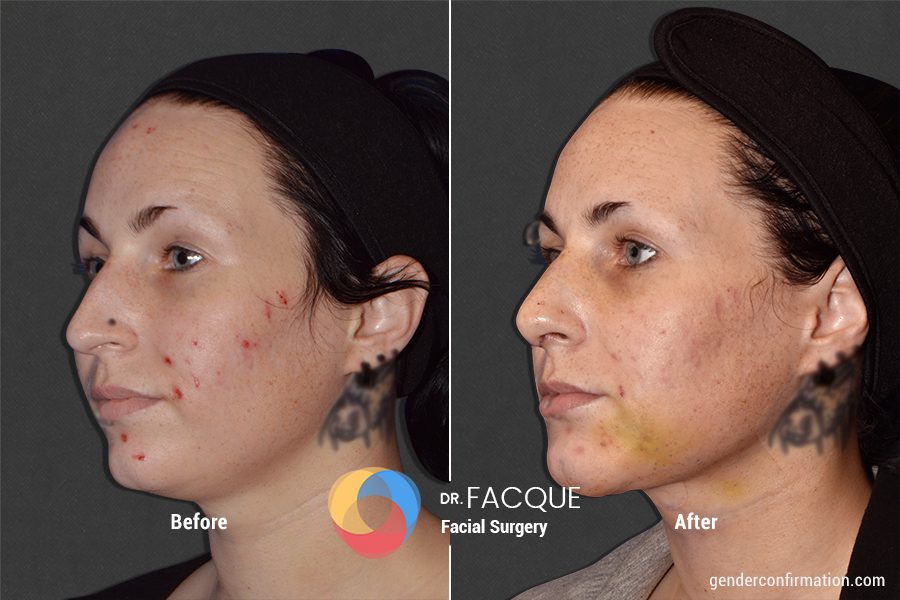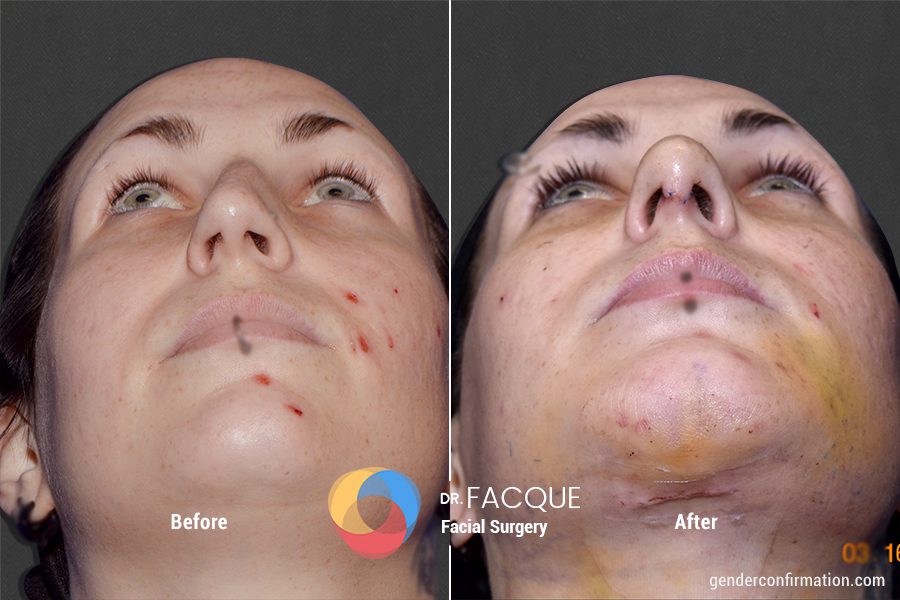Facial Feminization Surgery (FFS) & Gender-Affirming Facial Surgery 101
Medically reviewed by Dr. Scott Mosser on March 13, 2024.
Here you can find answers to all of your questions about Facial Feminization Surgery (FFS), Facial Masculinization Surgery (FMS) and other gender affirming facial surgeries.
On This Page
Facial feminization before and after + facial masculinization
All Your Options on the Table: Facial Surgery Techniques
Preparing for facial surgery: what to consider on the road to your operation
Facial Feminization Surgery (FFS) and other forms of facial gender harmonization like Facial Masculinization Surgery (FMS) refer to a series of procedures designed to help a patient feel greater gender congruence with their facial features. FFS often involves giving the face a softer, more conventionally feminine appearance. Our surgeons also have experience with masculinizing and androgenizing techniques. In a free, virtual consultation, patients can create a unique surgical plan to alter features in any of the following areas: the upper (hairline, brow bone & eyebrows), middle (nose & cheeks) and/or lower (lips, chin, jaw & trachea or Adam’s Apple) thirds of the face.
The GCC (Gender Confirmation Center) is one of the leading gender surgical practices in the world. Since 2009, our board certified surgeons have performed over 4,000 gender affirming procedures using state-of-the art medical technology. Our insurance advocacy team has helped 90% of interested patients secure coverage for their gender affirming procedures. At the GCC, we are committed to working with patients of all gender identities, regardless of hormone usage, body mass index (BMI), age or disability. You can learn more about our experienced facial surgeons below. For questions about recovery, you can visit this page.
Both Dr. Ley (she/her) and Dr. Facque (he/him) are trained and experienced in working with clients of all gender identities to help them feminize, masculinize and/or make certain features of their face appear more androgynous. If you have questions about how you can achieve your goals through gender affirming facial surgery, you can schedule a free, virtual consultation with one of our surgeons today.
Facial Feminization Surgery Before & After:
Facial Masculinization Surgery Before & After:
Gender affirming facial surgery is designed to target features of the face that often change during a first, testosterone-dominant puberty: augmenting or reducing them. By focusing interventions on key areas of the face, gender affirming facial surgery can empower patients to feel more connected to their internal sense of self that they want to share with the world.
Below is a brief list of the different procedures available in each region of the face/neck. We focus mainly on FFS because of its comparatively high demand. For more information on facial surgery designed to androgenize or masculinize the face, you can refer to this article. For questions about recovery, you can visit this page.
Upper Third of the Face
- Hairline advancement a.k.a. hairline lowering (skin)
- A receding hairline is a common result of having high levels of testosterone in the body over time. Also called hairline lowering, this procedure uses an incision around the forehead to reshape the hairline. The focus here is on rounding the corners of M-shaped hairlines, making the forehead appear shorter and more round. This can help eliminate the need for hair transplants on the forehead and is usually performed through the same incision as the brow lift. The scarring this procedure creates can be minimized and made almost invisible with proper care.
- Brow lift (skin)
- Lifting the eyebrows is a procedure that can make the face look more feminine by allowing the brows to sit higher on or above the brow bone. A brow lift can also make the eyes appear larger. This can be accomplished simultaneously with a hairline advancement, which will leave the same scarring at the hairline.
- Frontal sinus removal/setback or augmentation (bony structure)
- Setback: The brow bone can be more protrusive on the face in some people who underwent a first, androgenic (testosterone-dominant) puberty. This procedure reduces or reshapes the brow bone to allow the upper third of the face to appear softer, more open and less prominent.
- Augmentation: Patients with a flat forehead to begin with can elect to have the shape of their forehead augmented with implants. A protruding brow line is a common effect of a first, androgenic (testosterone-dominant) puberty; thus, augmenting the forehead can result in a more conventionally masculine look.
- Scarring: Both procedures can be accomplished at the same time as a hairline advancement. Alternatively, your surgeon can complete this procedure through an incision in your scalp to hide the scar in your hair, making it invisible.
Middle Third of the Face
- Cheek augmentation (soft tissue/fatty compartment)
- Estrogenic puberties tend to result in much fuller cheeks than androgenic (testosterone-dominant) puberties. This procedure can involve the use of cheek implants, fillers, or analogous fat transfer from elsewhere on the body. Cheek augmentations help make the appearance of cheekbones more prominent, which can give the face more of a heart shape. This procedure leaves no visible scars
- Rhinoplasty (bony structure)
- A gender affirming “nose job” tends to focus primarily on the nose bridge. Estrogenic puberties tend to result in narrower, smoother nose ridges whereas testosterone puberties tend to result in more prominent ones. A rhinoplasty can make any other adjustments to the nose. This procedure makes a small incision between the nostrils that usually heals to become invisible, leaving no scar.
Bottom Third of the Face
- Lip lift & lip augmentation
- A lip lift involves creating an incision at the base of the nose, which allows the surgeon to pull up the skin above the upper lip. This makes the upper lip look more prominent, giving it a more feminine appearance. This procedure leaves a small scar at the bottom of the nose that often looks barely noticeable after proper scar care.
- A lip augmentation is most often performed as an analogous fat transfer, though a more temporary filling of hyaluronic acid can be applied.
- Jaw contouring or augmentation
- Mandible contouring is a common part of many FFS procedures. For most folks who went through a first, androgenic puberty, the jawbone is prominent and wider. This technique shaves down some of the jaw and reshapes the chin to create a more narrow and softer look to the bottom third of the face.
- To augment the jaw, patients can opt for implants to be placed onto the mandible, giving them a more prominent, angular jawline.
- Genioplasty/chin reduction (bony structure)
- A feminizing genioplasty can help soften the look of the chin by changing the often square-shape to a more narrow shape.
- Conversely, patients can have the shape and size of their chin enhanced to make its form more prominent and angular.
Neck
- Tracheal shave (soft tissue/fatty compartment)
- For many patients who went through a first, androgenic puberty, the thyroid cartilage in the throat area enlarges during puberty. This procedure shaves the neck bump or Adam’s Apple down so it appears less prominently without impacting the vocal cords.
- Patients can also have their thyroid cartilage surgically augmented to create the appearance of a protruding Adam’s Apple.
If you have questions about which facial surgery techniques would be right for you, you can speak with one of our surgeons in a free, virtual consultation.
Create a unique surgical plan based on your goals, body type and medical history. Have all your doubts about surgery answered; no question is too trivial or too personal.
If you would like some guidance on figuring out how to get surgery, we have your back. The guide below goes over everything you need to know to get a surgery date and prepare yourself for a gender affirming facial surgery operation.
-
 What are the steps involved in getting facial surgery?
What are the steps involved in getting facial surgery? -
From requesting a consultation to obtaining insurance approval, we have you covered with our FFS timeline guide.
-
 Will my insurance cover this surgery?
Will my insurance cover this surgery? -
You can leave the insurance worries to us. The GCC provides a free insurance concierge service to interested patients. After soliciting any necessary documents from you, our insurance advocacy team will get to work to secure full or partial coverage for your medically necessary, gender affirming procedure(s). Our team has a 90% success rate in securing coverage for insured patients. Learn more about those services here.
-
 How can I finance my surgery if it’s not covered or only partially covered by insurance?
How can I finance my surgery if it’s not covered or only partially covered by insurance? -
We have compiled a list of scholarships for gender affirming surgeries alongside trusted, medical credit agencies you can use to help finance your surgery with us. You can also find estimated costs for each procedure we offer if you plan on paying entirely out of pocket. Click here for more.
-
 Do I need a letter of approval from a therapist, psychiatrist or primary care doctor to get surgery with GCC?
Do I need a letter of approval from a therapist, psychiatrist or primary care doctor to get surgery with GCC? -
Letters of support or clearance letters from certified, mental health professionals are welcome and valuable, but not a requirement for adults who seek surgery with the GCC. This is because we use the informed consent model, which means that a letter from a therapist is not required unless the patient is seeking insurance approval.
Insurance companies always require a letter of support from a mental health professional for approval. If our reconstructive surgeons are outside of your provider network, you will also need a reference letter from your primary care provider to request insurance coverage. For more information, click here.
-
 What about patients who are traveling from out of town to San Francisco for surgery?
What about patients who are traveling from out of town to San Francisco for surgery? -
Many trans, non-binary and gender expansive patients need to travel to access a board-certified, experienced gender affirming surgeon. At the GCC, we are very accustomed to working with patients from out of town. For recommendations on travel and lodging, click here. We have also compiled a guide on post-operative follow-up protocols for facial surgery patients who do not live in the San Francisco Bay Area.
-
 Do I need to be taking hormone replacement therapy (HRT) to get facial surgery?
Do I need to be taking hormone replacement therapy (HRT) to get facial surgery? -
Absolutely not. At the GCC we are committed to serving patients of all gender identities. We only require HRT for patients undergoing certain bottom surgery procedures. We take an individualized approach with our patients to design a surgical plan that meets their unique goals.
When it comes to facial surgeries, HRT can only alter soft tissue. Most commonly, estrogenic HRT redistributes fat to increase volume of the cheeks and soften the browline; the opposite is true for testosterone HRT. HRT cannot change bone structure, which is why many patients seek out facial surgery to change the overall structure of their face. Though not a requirement, if you are considering or currently taking HRT, we encourage you to talk to one of our surgeons about how that might factor into your surgical timeline.
-
 How can I best prepare for FFS or another facial surgery?
How can I best prepare for FFS or another facial surgery? -
We have created a guide specifically for facial surgery patients on how they can prepare for surgery in the days leading up to it. There, you will find information on getting medical clearance to tips on how to improve your recovery process.
After making it through the initial recovery process, patients of FFS and related surgeries have very high satisfaction rates with their results. You can gauge the integrity of the surgical process by making sure that your surgeon is board certified and highly experienced working with trans, non-binary and gender non-conforming patients.
If you are interested in creating a plan for your facial surgery, you can speak with one of our surgeons in a free, virtual consultation.
-
 Dr. Alexander Facque (he/him)
Dr. Alexander Facque (he/him) -

Dr. Alexander Facque (he/him) is a board-certified plastic surgeon and proud member of the LGBTQ+ community. Dr. Facque got his start in gender-affirming care as a resident at the Icahn School of Medicine at the Mount Sinai Medical Center in New York, where he first recognized the importance of providing safe and accessible surgeries to trans and non-binary patients. He then spent a year training and expanding his knowledge under Dr. Loren Schechter, one of the world’s foremost gender-affirming surgeons, as a fellow at Weiss Memorial Hospital’s Gender Confirmation Surgery and Practice Leadership in Chicago. Dr. Facque officially joined our team in 2020 and brought with him over 5 years of previous experience in gender affirming facial surgery, top surgery and body contouring. -
 Dr. Ellie Zara Ley (she/her/they)
Dr. Ellie Zara Ley (she/her/they) -
Dr. Ellie Zara Ley (she/her/they) is a board-certified plastic surgeon and the only transgender woman of color to offer a full-spectrum specialization in gender affirming surgery: top surgery, bottom surgery, facial surgery and body contouring. She also specializes transgender adolescent care. She is highly trained, having completing her general surgery residency at University of Arizona, a fellowship in plastic and reconstructive surgery at the University of Utah, a fellowships in craniofacial and pediatric plastic surgery at Primary Children’s Hospital in Salt Lake City and another in hand surgery and microsurgery at the University of Southern California. Prior to joining our team in 2022, she worked as an assistant clinical instructor of plastic surgery at the University of Utah and had her own private practice in Arizona.
Do you have specific questions about top surgery? You can get them answered and start the journey to getting top surgery by requesting a free, virtual consultation with one of our board-certified surgeons today.
Request a Free Surgical Consultation Today.
All virtual and in-person consultations with our board-certified surgeons are free. Once you fill out this form, our patient care team will reach out and guide you through every step to get to surgery.



